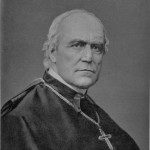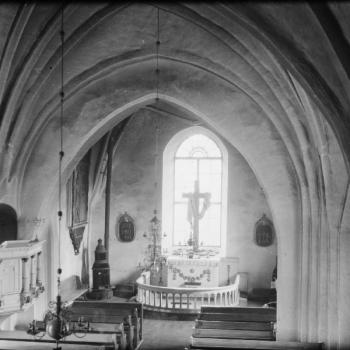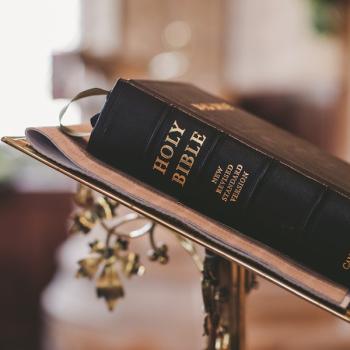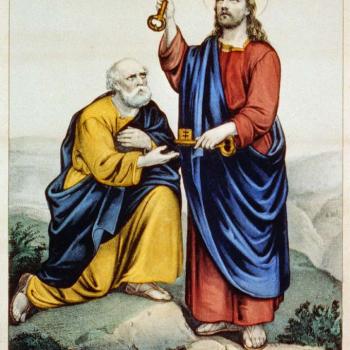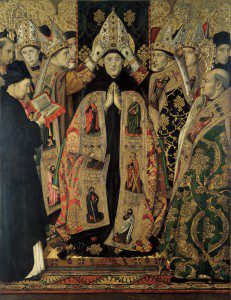
Let it not be said that this piece applies to all traditionalists in a Latin context. I have great respect for the Latin Mass and have many a friend who prefers it to the Novus Ordo. It is also not an endorsement of particular changes in pastoral approach. Its goal is to problematize and complicate our view of history so that a fruitful discussion might be had. I ask you to please read with this in mind.
(Considering the response this piece elicited, I have written a response to my critics, which can be found here).
Tensions in the Church seem to be rising. From the very existence of websites “in Union with Rome,” who otherwise seem dedicated to attacking Pope Francis, to Amoris Laetitia, to Bernie Sanders’ Vatican visit and Catholic turn, old questions are up in the air again: can the Church fall into error? Did Vatican II change everything? Can a German prelate ever be trusted? As a practicing Ruthenian Catholic, this probably isn’t my business. But as someone who grew up not knowing the richness of the Faith, who upon embracing it, attended Latin Masses whenever possible, and who went to a Latin Mass just this past Christmas, I feel obligated to speak.
There was a time when I would have identified myself as a traditionalist, and in some ways I really remain so. I’ve attended my fair share of “bad” Novus Ordo liturgies that have made prayer difficult. But I can no longer remain quiet in the face of an increasingly vocal minority, some explicitly not in union with the Church, others who say viciously attack it, but do not leave. Many such people seem to lack historical consciousness; they have made an idol of a form of Catholicism no more than about 200 years old. In short, they, both liturgically and pastorally, worship customs barely twice as old as Vatican II; to riff on a famous Chesterton quip: they’ve minds so closed they’ve shut out not just what came after Vatican II, but what came before the 19th century as well.
The first point of interest is the liturgy (lex orandi, lex credendi, after all). In truth, the pre-Vatican II Mass was often unsung, what today we would call a Low Mass. There’s nothing wrong with such a liturgy, of course; it was just much more common during the period to have people saying rosaries in the pews or otherwise not actually take notice of the sacrifice being offered (very little ecce homo taking place, if I might mix moments in Christian history). Many of my older Catholic friends remember the Mass of their younger years as a highly uninvolved, often unsung, ritual. It was not what the Latin sacrifice looks like today; in fact, the Mass was too often something stultifying, misunderstood, and otherwise deadened. Ironically, then, Vatican II has been amazing for the Latin Mass. Wonderful priestly societies like the Priestly Fraternity of Saint Peter and the Institute of Christ the King have arisen to offer the liturgy in Latin, bringing forth a renewal of the Mass: mostly sung, highly-participatory, and beautifully- and carefully-executed. Witness Joseph Ratzinger, later Pope Benedict XVI:
[I]t must be admitted that the celebration of the old liturgy had strayed too far into a private individualism, and that communication between priest and people was insufficient. I have great respect for our forefathers who at Low Mass said the “Prayers during Mass” contained in their prayer books, but certainly one cannot consider that as the ideal of liturgical celebration! Perhaps these reductionist forms of celebration are the real reason that the disappearance of the old liturgical books was of no importance in many countries and caused no sorrow. One was never in contact with the liturgy itself. On the other hand, in those places where the Liturgical Movement had created a certain love for the liturgy, where the Movement had anticipated the essential ideas of the Council, such as for example, the prayerful participation of all in the liturgical action, it was those places where there was all the more distress when confronted with a liturgical reform undertaken too hastily and often limited to externals. Where the Liturgical Movement had never existed, the reform initially raised no problems. The problems only appeared in a sporadic fashion, when unchecked creativity caused the sense of the sacred mystery to disappear.
This irony aside, however, certain traditionalists miss the deep variety of our liturgical tradition. Not only is the Catholic Church actually 24 separate Churches, most of which have long combined with vernacular with liturgical languages, but its past, even within the Latin Church alone, is variegated. Here, I let a document from the Vatican speak:
The use of a sacred language in the liturgical celebration is part of what St. Thomas Aquinas in the Summa Theologiae calls the “solemnitas.” The Angelic Doctor teaches: “What is found in the sacraments by human institution is not necessary to the validity of the sacrament, but confers a certain solemnity, useful in the sacraments to exercise devotion and respect in those who receive it” (Summa Theologiae III, 64, 2; cf. 83, 4).
Sacred language, being the means of expression not only of individuals, but rather of a community that follows its traditions, is conservative: it maintains the archaic linguistic forms with tenacity. Moreover, introduced in it are external elements, in so far as associated to an ancient religious tradition. A paradigmatic case is the Hebrew biblical vocabulary in the Latin used by Christians (Amen, Alleluia, Hosanna, etc.), as St. Augustine already observed (cf. “De doctrina christiana,” II, 34-35 [11, 16]).
In the course of history a wide variety of languages has been used in Christian worship: Greek in the Byzantine tradition; the different languages of the Eastern traditions, such as Syriac, Armenian, Georgian, Coptic and Ethiopic; Paleo-Slavic; the Latin of the Roman rite and of the other Western rites.
Interestingly, the point here is to defend the use of liturgical languages like Latin (something I am fine with, as Ruthenians love to declare: Slava Isusu Christu! Slava na Veeky!) Regardless, the intended takeaway on my part is the recognition of the validity and expressiveness of all languages in celebrating the liturgy. We are not Muslims. We do not think God has spoken authoritatively and only in one language. An anecdote about Patriarch Maximos IV Sayegh of the Melkites from the Second Vatican Council ought to both reinforce this point and allow me to move on:
At Session I of the Council, Maximos’ electrifying opening speech on October 23, 1962, set the tone for the Melkite onslaught on the one-sided, Latin vision of the Church. He refused to speak in Latin, the language of the Latin Church, but not, he insisted, of the Catholic Church nor of his. He refused to follow protocol and address “Their Eminences,” the cardinals, before “Their Beatitudes,” the Eastern patriarchs, for in his ecclesiology patriarchs, the heads of local Churches, did not take second place to cardinals, who were but second-rank dignitaries of one such communion, the Latin Church. He also urged the West to allow the vernacular in the liturgy, following the lead of the East, “where every language is, in effect, liturgical.” And he concluded, in true Eastern fashion, that the matter at any rate should be left to the local Churches to decide. All this in his first intervention at the first session! No wonder numerous Council Fathers, overcoming their initial surprise, hastened to congratulate him for his speech. And no wonder it hit the news. That was a language even journalists impervious to the torturous periods of “clericalese” could understand. Maximos spoke simply, clearly, directly—and he spoke in French.
Note something else important in what we’ve explored thus far: the Latin Church itself once had (and still, to an extent, has) an abundance of rites. The Ambrosian and the Mozarabic being the two more notable from before Vatican I, though the Anglican Ordinariate works in a similar (though not identical) way. The Mass so valued by some traditionalists is one recension of the Mass that emerged post-Trent and underwent modification in a variety ways straight down to Vatican II (the history of the chasuble is an interesting example).
Obviously, however, the malleability of the liturgy is not the only question raised by more rabid traditionalists. Many think the Church is changing fundamentally, that it is forsaking long-held beliefs, whether about marriage, proper respect due to priests, or the place of the tabernacle (one can find various examples on this site). And yet, as per usual, the history of the Church is vastly more complicated than many would like to believe. Some seem to think the practices of the 19th-century Church were those of the centuries immediately prior, as well as those of the Middle Ages, straight back to the Ascension, when Jesus went up into heaven, covered in lace and highlighted with the most subtle chiaroscuro—truly our Lord’s glorified body was a Baroque masterpiece, but I digress.
Of course, these traditionalists (and, again, not all of them) have a warped view of the past. Communion was probably originally given in the hand (here’s Rorate Caeli admitting just that). There was a time when priests could be married in the West (as recently as a thousand years ago), and they still can be married in the East (even among Eastern Catholics). It would seem then that pastoral practices differed, and can differ, rather extremely within the various expressions of the Faith. On another note, marriage was not officially a Sacrament until the 13th century. This juicy bit from a professor of medieval history should interest some:
For peasants, divorce was a lot easier. You just moved out, and then everyone related to either half of the couple got involved in bitter wrangling. As long as neither half of the couple remarried–or at least not without moving very far away first–the church neither knew nor cared.
This is not a statement (on my part) in favor of any contemporary “side” on an issue. But it is interesting: the point being that the Church’s responses to things have varied over time. One might look to the Orthodox to see how different marriage can look across certain boundaries. Again, history is complex.
Then there’s the fact that people were allowed to play with the Bible and other sacred texts and notions in all manner of zany ways. We have two Old English versions of Genesis (couched in pretty weird terms: one here and one here), an Old English Exodus (a poem that reimagines the fleeing Hebrews as Anglo-Saxon warriors), an Old English work that celebrates the Cross in terms almost offensive to the contemporary ear, a bible in Gothic, and a Latin martyr narrative in which a woman becomes a man. Being playful with Scripture, even with belief, was fine. If certain traditionalists think priests were somehow bastions of morality before Vatican II, I invite them to read Piers Plowman, The Canterbury Tales, or even just medieval papal documents chastising the clergy and people for their wicked attitudes (one example, regarding Jews, here). Perhaps I ought not to mention the gentleness of St. Francis de Sales in the face of the Protestant Reformation or the immense trust put in St. Alphonsus Liguori:
Still it must in fairness be admitted that all priests are not great theologians able to estimate intrinsic probability at its true worth, and the Church herself might be held to have conceded something to pure probabilism by the unprecedented honours she paid to the Saint in her Decree of 22 July, 1831, which allows confessors to follow any of St. Alphonsus’s own opinions without weighing the reasons on which they were based.
I might also be remiss to mention the marriage controversy surrounding Byzantine emperor Leo VI, who turned to the Pope so that he could marry his mistress (his fourth marriage), because the Patriarch of Constantinople was too strict (basic reference material here).
Finally, it seems important to mention this book (reviews here and here). The basic point of Lehner’s text is that the post-Trent Church contained decently-active strains interested in synthesizing Church thought with Modern philosophy. It was only the French Revolution and other violent anti-clerical outbursts that led to “Modernism” becoming a bad word, something so capacious that any non-Thomist could be suspect. From the former review posted above:
Dr. Lehner concludes his book with the critical observation that the radicalism of the French Revolution—especially its anti-Catholicism—destroyed any real hope for a continuation of any coherent or cohesive liberalism. Instead, the Church centralized around the papacy, often turning “theology into ideology in order to secure societal influence and to silence dissenters.” Importantly, especially for the nineteenth century, the Church created a bulwark against liberalism, modernity, and individualism, seeing each as fundamentally selfish. Right or wrong—for Dr. Lehner offers no judgment—“Catholicism withdrew into an intellectual ghetto.” Individual Catholics challenged this orthodoxy from time to time, but not until the Second Vatican Council (1962-1965) did a coherent voice of liberalism emerge from within the Church, returning (but only slightly) to the ideals of the Catholic Enlightenment of the pre-French Revolutionary period.
The Catholic Enlightenment is not only one of the best books I have had the privilege of reading this year, it is certainly one of the best books of history I have ever read. Ulrich Lehner is a top-flight Christian humanist and, from what I know of him, a true Catholic gentleman. Long may he and his scholarship be the model for us all.
This “intellectual ghetto” might just be the one worshipped by such rigid traditionalists, a Church rooted in one moment, in denial about its own historical nature, and convinced of its own righteousness, even in the face of its own hypocrisy, or dare I say turpitude.
I give this rebuke in charity, for I am a sinner, like all others. In this spirit, I leave you not with words of condemnation, but with words of healing and unity, of obedience, expressed by a medieval saint near and dear to my heart:
Obey your bishop! “Obey those set over you [Heb 13:17],” the teachers of the Church…. I remind you, my dear friends, of what I said when I was with you: do not receive any outside or unknown preacher, unless he be sent by your bishop or preaches with the permission of the pope. For “how shall they preach unless they are sent [Rom 10:15]?”


